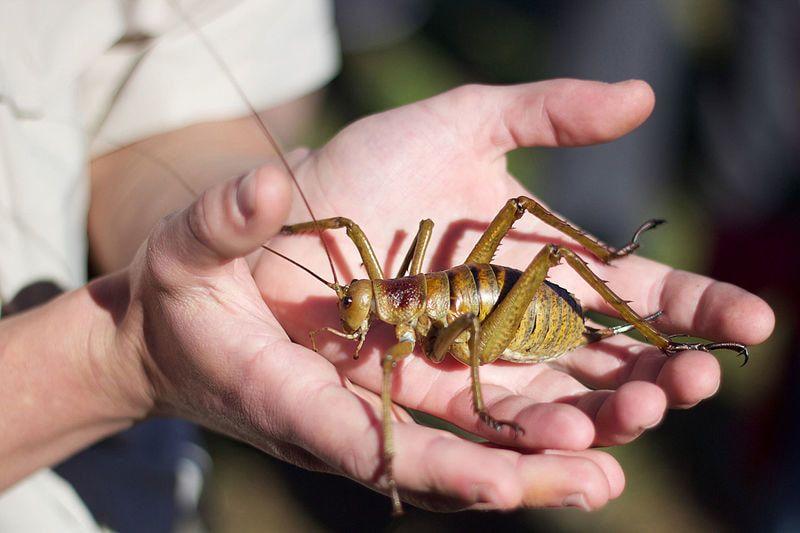If you are familiar with the Rocky Mountains region, you must have heard about the infamous Mormon cricket. These pests are known for their destructive feeding habits, and their population explosions can cause significant damage to crops and pastures. In this article, we will take a detailed look at what Mormon cricket is, its life cycle, feeding habits, control measures, and much more.
The Mormon cricket, Anabrus simplex, is a species of katydid that belongs to the Tettigoniidae family. It is a large insect, with females measuring up to 70 mm in length, and males about 50 mm.
The insect gets its name from the fact that it was first documented in the Great Salt Lake region of Utah, which was populated primarily by members.
Life Cycle of Mormon Crickets
Mormon crickets have a complex life cycle that spans several stages, from eggs to nymphs. The female cricket lays its eggs in the ground during the late summer or early fall. The eggs remain in the ground until the following spring when they hatch into nymphs.
The nymphs resemble smaller counterparts of the cricket and lack wings. They undergo several molts, where they develop wings and become sexually mature. The entire life cycle of a Mormon cricket lasts about one year.
Level of the Egg
The Mormon cricket’s life cycle starts with the egg stage. In the late summer or early fall, after mating, the female cricket will lay her eggs on the ground. The eggs are laid in shallow burrows and stay there all winter, waiting for the weather to warm up so they may hatch.
Nymphal Phase
When the weather warms up in the spring, the cricket eggs hatch into nymphs, which are young adults. These immature offspring look much like their parents, but they don’t have wings or reproductive organs just yet. The nymphs lose their exoskeletons in a series of molts that happen over a few weeks as they mature into their adult colors and sizes.
Stage of Youth
While still in their juvenile stage, Mormon crickets keep growing and molting, eventually developing the characteristics that set them apart as adults. During this critical developmental period, kids fortify themselves physically and mentally to face the difficulties that are to come. During this time, they undergo a metamorphosis and speedy growth spurt as they devour plants.
When Mormon crickets reach maturity, they are prepared to take part in the mating ritual and help ensure the species’ continued existence. To entice females, adult males make unique mating calls, and females evaluate possible partners according to several criteria, including size and energy. The life cycle of a species is completed when a female lays eggs after mating.
Swarming and Migration
The Mormon cricket’s tendency to swarm and migrate is one of the most fascinating parts of its life cycle. Mormon crickets swarm as a unique collective response when food supplies become scarce or environmental circumstances deteriorate. Massive migratory swarms of thousands of people traverse great distances in quest of food.
Because they devour everything in their path, these swarms may wreak havoc on ecosystems and farming. Nevertheless, they play an essential ecological role by transferring nutrients and aiding in the decomposition of organic materials. Mormon crickets, for all their trouble, are an example of how nature can adapt and persevere.
Feeding Habits of Mormon Crickets
Mormon crickets are primarily herbivorous and feed on a variety of plants, including grasses, forbs, and shrubs. They are known for their voracious appetite and can consume up to their body weight in plant material each day.
During population explosions, the crickets can cause significant damage to crops and pastures, leading to significant economic losses.
Control Measures for Mormon Crickets
Mormon cricket infestations can be challenging to control, but there are several methods available. One of the most effective methods is the use of insecticides, which can be applied to crops or directly to the insects themselves. However, the use of insecticides can have negative environmental impacts, so they should be used judiciously.
Another effective control method is the use of biological control agents, such as predatory birds and insects. These natural predators can help keep the cricket populations in check and reduce the need for chemical insecticides.
Mormon Crickets and Human Health
While Mormon crickets are not typically considered a direct threat to human health, they can pose some risks. During population explosions, the insects can swarm roads and highways, causing traffic accidents. They can also carry diseases that affect livestock and humans, such as tularemia and plague.
FAQs
What is Mormon cricket?
A Mormon cricket is a species of katydid that is known for its destructive feeding habits.
Where do Mormon crickets live?
Mormon crickets are found primarily in the Rocky Mountains region of the United States.
How do Mormon crickets reproduce?
Female Mormon crickets lay their eggs in the ground, which hatch into nymphs the following spring.
Can Mormon crickets pose a threat to human health?
While Mormon crickets are not typically considered a direct threat to human health, they can carry diseases that affect livestock and humans, such as tularemia and plague.
How can Mormon cricket infestations be controlled?
Mormon cricket infestations can be controlled through the use of insecticides, biological control agents, and other methods such as cultural practices.
What are some natural predators of Mormon crickets?
Some natural predators of Mormon crickets include predatory birds and insects such as beetles and wasps.
How can I protect my crops and pastures from Mormon cricket damage?
You can use insecticides, natural predators, and cultural practices such as crop rotation and planting resistant varieties to protect your crops and pastures from Mormon cricket damage.
Conclusion
Mormon cricket is a fascinating and destructive insect that can cause significant economic losses. Understanding their life cycle, feeding habits, and control measures is essential for farmers and other stakeholders in the Rocky Mountains region. By taking appropriate control measures and using natural predators, we can help reduce the impact of these pests on our crops and pastures.
Snow Cone: A Delicious Summer Treat




